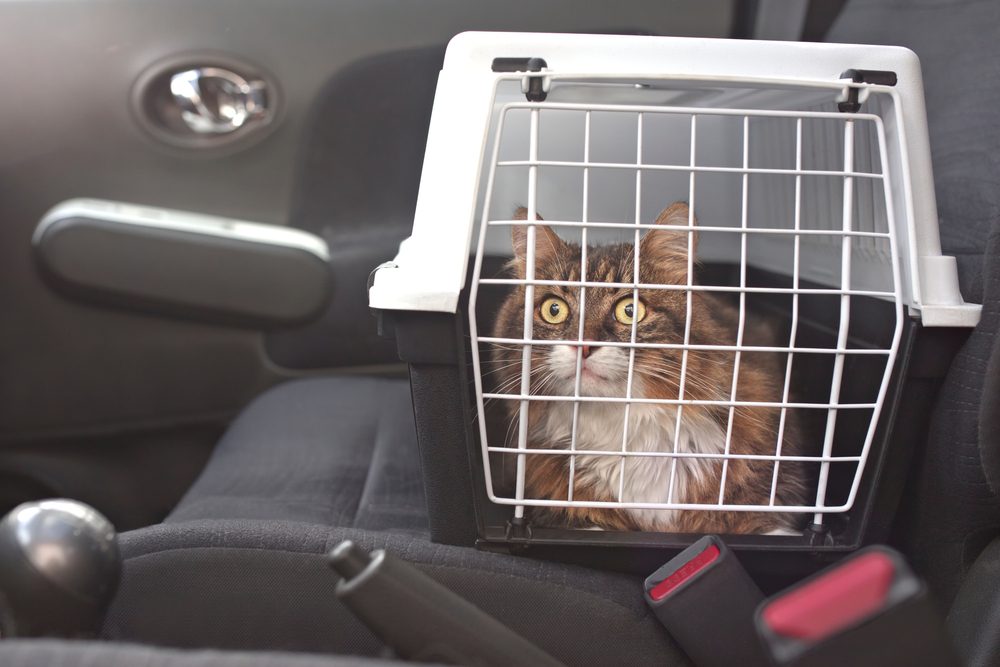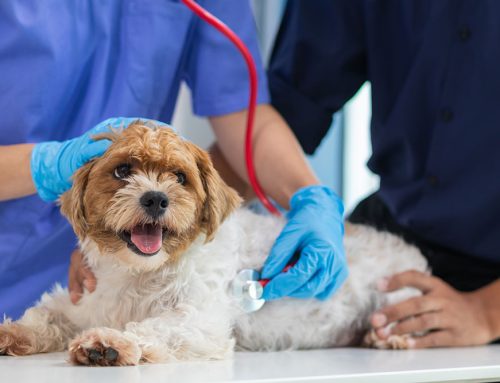With forecasted highs for Liberty Township approaching or exceeding 90 degrees for most of August, it is paramount that pet owners remember these five heatstroke prevention tips, to keep their fur-coat-wearing buddies safe this summer.
#1: Understand how heatstroke occurs in pets
Heatstroke is more common in dogs than cats, and occurs when a pet is unable to maintain a normal body temperature. Typically, dogs maintain their body temperature through:
- Evaporation — Evaporation of water from the tongue of a panting dog is one of the main methods of cooling, but is less effective on a humid day.
- Conduction — The skin of the abdomen in contact with a cool surface helps transfer heat away from the dog’s body. This is why a hot dog will flop on the cool tile floor instead of their fuzzy bed.
- Convection — The movement of air over the body, from the wind or a fan, helps get rid of heat.
- Radiation — Heat from a dog’s body transfers into the environment to cool the dog, but this becomes less effective when the air temperature is close to the dog’s body temperature.
When these cooling mechanisms become overwhelmed, heatstroke can occur. There are two types of heatstroke—exertional and non-exertional. Exertional heatstroke occurs when an animal has been exercising in a hot environment, while non-exertional heatstroke results when an animal is confined to a hot location, such as a parked car, or a yard without shade or water.
#2: Watch for factors that put your pet at risk for heatstroke
Given the right situation, any dog can suffer from heatstroke, but some are more prone to the problem because of these factors:
- Coat characteristics — Coats that are black or thick retain more heat.
- Age — Dogs who are young or old have more trouble maintaining an appropriate body temperature.
- Head shape — Brachycephalic dogs (i.e., those with flat faces and short noses) have smaller nasal openings and passages, and a narrow trachea, making heat dissipation more difficult.
- Body condition — Fat is an insulator that is great for staying warm in the winter, but makes overweight dogs more prone to overheating in the summer.
- Medical conditions — Dogs with heart disease, laryngeal paralysis, or endocrine conditions may have more trouble maintaining normal body temperature.
#3: Recognize heatstroke signs in your pet
Many people who have taken a long walk on a warm day have noticed their dog panting hard, gulping down a bowl of water, and then lying on the cool floor after arriving home. This behavior is typical for pets with heat exhaustion or heat stress, and presents minimal risk. Heatstroke, however, is more concerning, and necessitates immediate action to keep your pet safe. Heatstroke signs include:
- Noisy or excessive panting
- Bright red gums
- Diarrhea, which may be bloody or black
- Vomiting
- Collapse or staggering
- Tremors, seizures, disorientation, or loss of consciousness
#4: Know what to do if your pet suffers from heatstroke
If you think your pet is suffering from heatstroke, start cooling them, and immediately contact Liberty Veterinary Hospital. Wet your dog with cool—not cold—water, place them in front of a fan, and crank up the air conditioning. Never use ice or ice-water to cool your pet, and do not fully submerge them in water, especially if they are unconscious or seizuring. Dogs with heatstroke may have secondary damage to their liver or kidneys, problems with blood clotting, abnormal heart rhythm or function, or progressive neurologic damage, making it imperative that you bring your pet to our hospital for continued treatment and careful monitoring as soon as possible after you institute cooling measures.
#5: Prevent your pet from having heatstroke

While some heatstroke cases result from tragic accidents, such as unknowingly locking your pet in the car, or inadvertently leaving them out in the yard, other cases could be avoided by following these guidelines:
- Never leave your pet in the car during warm weather, whether “only for a few minutes,” the car is in the shade, and the window is cracked. On an 85-degree day, the inside of a parked car reaches 102 degrees in 10 minutes, and a blistering 120 degrees in 30 minutes—the perfect heatstroke set-up.
- Walk or exercise your pet in the cooler mornings or evenings rather than the hot middle of the day.
- Offer your dog water periodically when walking or hiking.
- Allow your dog to rest in the shade during outdoor activities, and do not force them to participate.
- Accustom your dog to activities such as running over a period of one to two months, to decrease the risk of exertional heatstroke.
If you want to consult with our Liberty Veterinary Hospital team about keeping your pet safe from the heat this summer, or are concerned your furry friend may be suffering from heatstroke, give us a call.








Leave A Comment